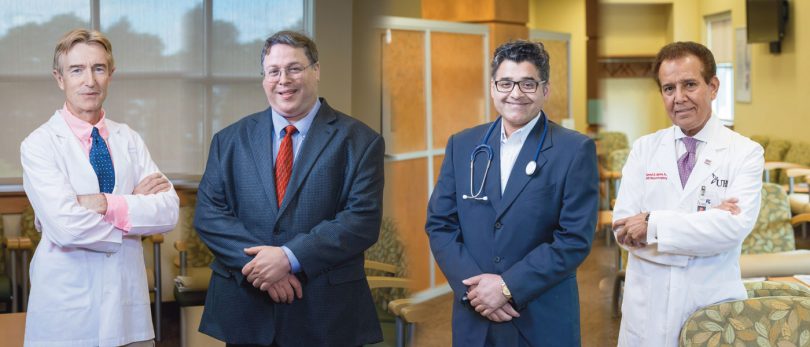For more than 30 years, the UHS Neurosurgery Center at UHS Wilson Medical Center has pushed the boundaries of neurosurgical care for illnesses and injuries of the brain and spine. And with more than 7,000 brain and spine neurosurgical procedures performed between 2013 and 2016, the center’s neurosurgeons have the experience to support their elite status.
A Collaborative Network
“What sets our program apart from other community hospitals is the fact that our neurosurgeons, neuroradiologists, radiation oncologists, neurointensivists, medical oncologists and neuro-support staff are all within the UHS system — working in concert, sharing electronic medical records and providing collaborative, individualized care for each patient,” explains Prakash Ramanathan, director of UHS Clinical Operations and Neuroscience Services.
To encourage this united approach, UHS has the critical infrastructure and services in place to support the best outcomes. This includes a dedicated neurosurgical operating room, a neurological intensive care unit (ICU) and a neurosciences step-down unit to serve patients who no longer need ICU care but still need a staff with specialized neurological training.
“The comprehensive work we perform is unparalleled for a community hospital,” says Saeed Bajwa, MD, UHS director of Neurosurgery. “Our level and depth of care are rarely, if ever, available outside of large academic hospitals located in major metropolitan cities. There’s no need to travel outside of Binghamton to receive the best neurosurgical care.”
New neurosurgeon joins UHS Neurosurgical Center
UHS Wilson Medical Center recently welcomed Barry J. Pollack, MD, certified by the American Board of Neurological Surgeons, to the neurosciences team. Dr. Pollack graduated from New Jersey Medical School, University of Medicine and Dentistry of New Jersey. He completed his internship in general surgery and his residency in neurosurgery at Northwestern University in Chicago.
Before joining UHS, Dr. Pollack treated patients at Cayuga Medical Center in Ithaca, and also at Eastern Maine Medical Center.
“With a fourth neurosurgeon on our team, Dr. Pollack’s talents and skills will also allow us to grow our volume of surgery — which at this point surpasses 2,000 operations a year,” says Saeed Bajwa, MD, director of Neurosurgery at UHS.
Targeting Success
To achieve this level of neurosurgical care, modern providers are relying more and more on the latest technological advancements, such as 3 Tesla (3T) MRI imaging. Specific to benign and malignant brain and spine tumors, 3T imaging provides the highest quality, most accurate image possible — so surgeons and radiologists can “see” what’s going on, deliver a quicker diagnosis and begin treatment faster — which ultimately leads to satisfactory outcomes.
If imaging indicates surgical removal of a tumor is the best course of treatment, UHS neurosurgeons have the right technology to guide them through the most delicate procedures, beginning with the StealthStation® Treatment Guidance System. This system allows surgeons to focus on the tumor’s exact location and avoid compromising healthy muscle, tissue, nerves or blood vessels. Benefitting the patient, the guidance system requires only a small surgical incision and expedites procedure time.
“It’s similar to GPS for your car,” explains Khalid Sethi, MD, UHS neurosurgeon. “The software guides us to the tumor’s precise location so we can identify the correct treatment technique. That’s key to providing the best patient care.”
Once the tumor is removed, the patient is typically transferred to UHS Radiation Oncology, where stereotactic radiosurgery (SRS) is performed to ensure that no tumor cells remain. The TrueBeam platform, a system for image-guided radiotherapy and radiosurgery, is a newer technology offered at UHS.
Turning to the Spine
An estimated 65 million Americans experience back and neck pain every year, and the UHS Neurosurgery Center is prepared to meet its patients’ needs. “Our neuro team can provide the complete spectrum of treatment for patients with spinal disorders,” says Dr. Bajwa.
That said, the general consensus among UHS physicians is to investigate non-invasive therapies to relieve back pain before rushing to surgery. “We’ll generally suggest physical therapy, a chiropractor or pain management therapy first,” says Mr. Ramanathan. “Now we also offer HF10 spinal cord stimulation, which involves a surgically-implanted electrical device that sends pain-relieving signals to the spinal cord.” (See Relief at Last for the story of a patient who got her life back after implantation of a spinal stimulation device.)
In matters of the spine, it is particularly crucial that the patient’s team of physicians, physical therapists and chiropractors are all on the same UHS team, Dr. Sethi emphasizes. “So when you see me in my office, I can read your physical therapist’s notes in your medical file; I know what pain management you tried; I see your MRIs. Ultimately, all this combined information and coordinated care helps identify if or when it’s time to consider surgical options.”
Right In Your Own Backyard
In addition to having the most advanced instrumentation and experienced clinical team to diagnose and treat spine and brain disorders, there is yet another attribute that sets the UHS Wilson Medical Center Neurosurgical Center apart, says Dr. Bajwa. “When you’re told you have, for example, a brain tumor, the emotional reaction is dramatic. And you think you have to leave your community and head off to New York City, Boston or Baltimore for the best care possible. When we explain to our patients that we have that same level of sophisticated expertise right here — right where their loved ones live — you can see the relief on their faces. It’s a first step to recovery.”
A wide scope of neurosurgery services
UHS brings adult patients in the Southern Tier advanced treatment capabilities for a wide scope of neurological conditions and injuries, with a noted specialty in providing neurosurgical care for brain and spine tumors. Whenever possible, UHS neurosurgeons use minimally invasive technology to guide them through delicate surgical procedures, minimizing penetration and incision, reducing healing time and significantly decreasing pain, scarring and complications. Neurosurgery services include:
- Spinal fusion, including implantation of the X STOP IPD device, to provide immediate and long-term relief of back and leg pain, often for treatment of spinal stenosis.
- Spinal decompression, including kyphoplasty, microdisectomy, intradiscal electrothermal annuloplasty (IDET) and percutaneous discectomy, to alleviate pain caused by conditions such as spinal stenosis, herniated disc and spondylolisthesis.
- Image-guided surgery provides great accuracy, requires only a small surgical incision, expedites procedure time, allows for advanced procedure planning and shortens the patient’s hospital stay.
- HF10 Spinal Cord Stimulation, available for the first time in the Southern Tier, uses high-frequency electrical stimulation to treat chronic back and leg pain. The addition of HF10 therapy at UHS Wilson Medical Center makes UHS one of the largest and most comprehensive neuromodulation centers in the country.
GET IT ALL
Learn more about the brain and spine conditions treated and procedures available at UHS.







